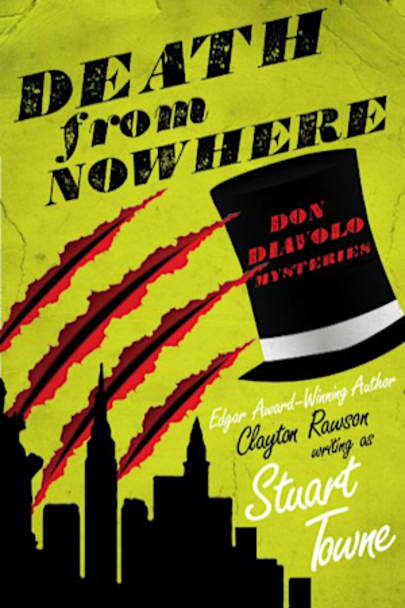Trapped in a dead man’s office, Don Diavolo plans his greatest escape This collection brings together two adventures with Don Diavolo, the Scarlet Wizard. The first opens in his machinist’s workshop, where Diavolo perfects his newest feat: the Escape from the Double Crystal Water Casket. The men lurking outside have no interest in the magician’s secrets–they are detectives, tailing him on behalf … detectives, tailing him on behalf of the police inspector. Giving them the slip is no trouble, but it proves a mistake, for Diavolo is about to be implicated in a murder. Diavolo is blackjacked as soon as he walks through the circus owner’s door, awaking just in time to be found standing over the corpse. To prove his innocence, the Scarlet Wizard must escape a trap more cunning than any crystal casket. His next adventure begins when an explorer lands at La Guardia airport, returning from India with a secret for which many men will die. Before Don Diavolo can unmask the killer, he must unlock the perplexing puzzle of the vanishing corpse.more



Author, editor, and amateur magician Clayton Rawson is best remembered as the creator of The Great Merlini, a magician who had a knack for solving seemingly impossible crimes. Under the pseudonym Stuart Towne, Rawson created Don Diavolo, a magician/escape artist/ventriloquist who was billed as “the Scarlet Wizard” for his bright red on-stage evening clothes. Diavolo appeared in four short novel-length tales which appeared in *Red Star Mystery*, a short-lived pulp fiction magazine from 1940, and tended—like Merlini (who’s alluded to in one of the novels)—to get involved in a variety of impossible crime situations.
Diavolo has his own cast of supporting players. These include reporter/columnist for the New York Press J. Haywood (“Woody”) Haines, Jr.; Karl Hartz, the engineer of Don’s stage illusions; Patricia Collins and her twin sister Mickey, Don’s on-stage assistants; the gambler of many aliases most often referred to as the Horseshoe Kid; and the Oxford-educated Chan Chandar Manchu, “Don’s dresser, chef, and general handyman.” Sure that only an illusionist of Diavolo’s caliber could pull them off, Homicide Squad’s Inspector Church regularly hopes to nail the magician for murders he cannot solve himself, despite Don’s ability to prove his innocence by explaining the *who* and *how* of the crimes.
The first story in DEATH FROM NOWHERE is “Claws of Satan,” which has Diavolo paying a visit to the offices of circus co-owner and generally unscrupulous businessman R.J. Hagenbaugh after the latter has stopped payment on a check for an illusion Diavolo sold him in good faith. When he arrives and Hagenbaugh’s attractive blonde secretary denies him admittance to her boss’s inner sanctum on the grounds that he’s in c skills to deceive her and gain admittance. When he does, he barely glimpses Hagenbaugh slightly slumped in his desk chair before he’s blackjacked by someone behind the door. From the time he awakes, he is, as far as Inspector Church is concerned, the prime suspect in the case. To acquit himself, Don must stay one step ahead of the police and solve a series of impossible murders the police are sure only he could have committed.
“The Enchanted Dagger” begins with the arrival in New York of a furtive individual who checks into a hotel after taking steps to conceal his identity, who then phones the unavailable Don Diavolo, and then not long after is attacked by a gun- and knife-wielding assailant. The problem for the police? Plenty of blood but no body to explain its presence.
What brings Diavolo into the predicament is an ongoing challenge from the wealthy Nicholas Sayre, whose hobby in retirement has become the occult in both the spiritual and collectible realms. He’s not fond of Diavolo because the magician once exposed a con artist to whom Sayre had made a sizable donation. Now “nothing would give him any greater pleasure than to make Don Diavolo admit, once and for all, that occult phenomena did exist which could not be duplicated by trickery and sleight of hand.” Diavolo once told Sayre he’d pay ten thousand dollars to anyone “who could produce a psychic manifestation I couldn’t duplicate by ordinary means.” Sayre contends he’s found one, a mystic named Shivara who can—and does—vanish before multiple viewers’ eyes, one pair of which is Don’s. Ultimately, Diavolo must solve a number of impossible situations, including murders, Shivara’s several psychic skills, and how an ancient treasure figures into modern events, as well as keeping himself from getting killed.
The Don Diavolo mysteries, are fast-paced short novels which combine cerebral conundrums with the kind of fast-paced physical action (and occasional hokeyness) the pulps were known for.
There are (fortunately *only*) a few instances of offensive racial epithets readers must put into the context of the era in which these short novels were written. As far as I can determine, physical editions of these tales are no longer available. I read them in the electronic editions from Mysterious Press/Open Road Integrated Media, which companies need to hire a competent proofreader. The novels contain their share of missing or incorrect punctuations, as well as occasional misspellings. The worst instance of misspelling occurs in “The Claws of Satan,” when the skin condition *vitiligo* is written *vitiglio*. Readers unfamiliar with this condition, and unable to find a definition of the misspelled word, might think the author has made it up.
With those caveats noted, I can and do recommend these as good entertainment.
© 2017 Barry Ergang